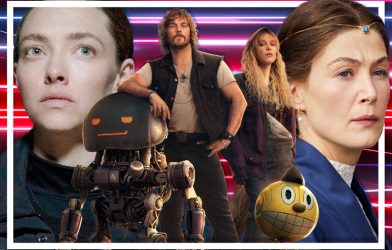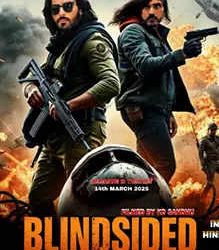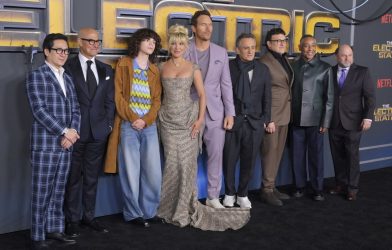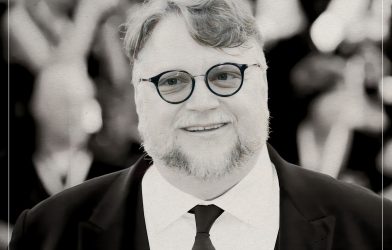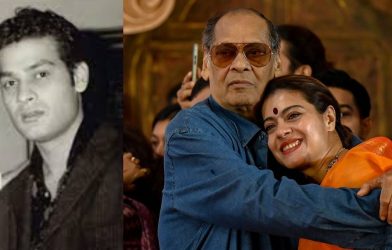I Saw the TV Glow is, on its surface, a movie about identity and teenage isolation. But it’s also about how we attach those ideas to art and entertainment consumption during our formative years. And on yet another level, A24’s new psychological coming-of-age drama is about the mediums through which art and entertainment are passed down. Largely set in the ’90s, the movie revolves around two teens, Owen and Maddy, who bond over a surreal YA television show called The Pink Opaque. (Think: Buffy meets A Trip to the Moon.) But Owen’s parents forbid him from watching—“Isn’t that a show for girls?” asks Owen’s dad, played by Fred Durst—so he can consume the series only in secretive ways. Specifically: VHS dubs of The Pink Opaque that Maddy makes for Owen and hides in the high school dark room. It’s a relic from the pre-streaming era that should feel familiar to older millennials—the idea that a piece of physical media could change your life.
It’s fitting, then, that A24 and director Jane Schoenbrun have staked a large part of the movie’s experience on another relic of the pre-streaming era: the compilation soundtrack. The I Saw the TV Glow OST is the type of project you don’t see much of in 2024. It’s a who’s who of indie music mixed with a handful of rising artists, all providing original recordings. The album, which was released on May 10 through A24 Music, features stars such as Phoebe Bridgers and Caroline Polachek alongside critical darlings Bartees Strange and L’Rain, plus exciting (relative) newcomers such as Sadurn and King Woman. On its own, it may be one of the best collections of songs you’ll hear all year. But tied to Schoenbrun’s tale of identity repression and awakening, the tracks take on vivid life. (Certain songs are inextricable from specific scenes—like Polachek’s “Starburned and Unkissed” playing as handwritten notes cover the screen, or Maria BC’s haunting “Taper” playing during Owen and Maddy’s early sleepover.)
For Schoenbrun, this marriage of sight and sound was always the vision for I Saw the TV Glow, which releases wide on Friday. The hope was to make something similar to the soundtracks for Donnie Darko, The Doom Generation, and John Hughes’s most famous movies—all indelible, and all inspirations Schoenbrun cites. (This was in addition to commissioning a gorgeous score by Alex G, who also worked on Schoenbrun’s last film, 2021’s We’re All Going to the World’s Fair.) The director—a self-described music nerd who grew up escaping to punk shows in New York City—even went as far as to make individualized playlists for artists to give them a sense of Schoenbrun’s thinking. “I knew that there was a sort of ground level of sad girl lesbian shit that I love and felt in line with the film, but I didn’t want it to just be that,” Schoenbrun says. “A great soundtrack needs to explore outwards, in the way that the Drab Majesty song does or the Proper song does. If it was just one thing 16 times, people would get bored really quickly. But if it was 16 things that all feel a piece of themselves, it could stand the test of time.”
That approach pays off throughout the film, like during King Woman’s visceral in-movie performance of “Psychic Wound” (a moment that will make any self-respecting Twin Peaks fan recall the Roadhouse performances) or yeule’s cover of Broken Social Scene’s “Anthems for a Seventeen Year-Old Girl,” which appears twice in I Saw the TV Glow. (It’s perhaps fitting that BSS’s 2002 original had another soundtrack moment in 2010, when it was featured in Scott Pilgrim Vs. the World.) Ultimately, despite the “various artists” label, the I Saw the TV Glow soundtrack feels like a cohesive document—a testament to not only how the movie ties the songs together, but also the work that Schoenbrun, A24, and music supervisors Chris Swanson and Jessica Berndt put into it.
“I didn’t want it to be the dumb soundtrack of pop-rock cover songs of ’70s hits or whatever,” Schoenbrun says. “I didn’t want it to become pastiche or an exercise for anybody, but I think I knew I was playing within this lineage of the Mallrats soundtrack or the Buffy original soundtrack. I wanted to create this thing that could conjure that memory. Because so much of what the film is trying to do is conjure that era of media.”
Much like the plot of the movie, the existence of this soundtrack seems both sentimental and unfamiliar. (Or, as Taja Cheek—who records under the name L’Rain and contributed the song “Green” to the project—tells me, “very nostalgic, but also really kind of fresh and new.”) While these types of compilation albums used to be the norm, the movie and music industries have shied away from them in the new economic and streaming realities. And in some cases, that’s maybe not a bad thing—the fewer blockbuster soundtracks, the fewer Godzilla-style abominations we have to deal with. But that also means fewer—if any—Doom Generations or Above the Rims or Empire Records. And that maybe means a world where original music doesn’t matter as much to a movie unless it’s a score by one of the few dozen composers who get regular work.
So the question becomes: If I Saw the TV Glow and its accompanying album succeed, do they have the potential to become almost a real-life extension of the Maddy-Owen VHS experience? Meaning: Could they pass down the soundtrack experience, making it easier for other filmmakers and studios to take similar risks? Because in this case, the medium is as fascinating as what it contains—and how it connects to the past.
:no_upscale()/cdn.vox-cdn.com/uploads/chorus_asset/file/25452279/87ece728b9322264b9f1341c3ea17e8081bfde78_5925x3949.jpg)
A24
For Swanson, one of the TV Glow music supervisors and the cofounder of indie music powerhouse Secretly Group, it was Pump Up the Volume. (“Pump Up the Volume actually made me want to start my own pirate radio station,” he says. “I was convinced that was my destiny.”) For Billboard writer Andrew Unterberger, it was not only beloved albums like the Singles and Kids OSTs, but also strange artifacts like the one for The Cable Guy. (“A couple hits from it, but do I actually remember any of those being in that movie? Maybe one, maybe two.”) For L’Rain—one of the stars of the I Saw the TV Glow album—it was Whitney Houston’s Waiting to Exhale. (“Just like, ‘Wow, look at all of these very famous women that are contributing to the soundtrack.’”) For veteran music supervisor Liz Gallacher, it was one of the forever classics: Pretty in Pink and all the Smiths and Echo & the Bunnymen that entailed. (“My absolute hero is John Hughes,” she says. “The way that he used music, it just spoke to me so much when I was younger.”)
Everyone interviewed for this pointed to a soundtrack or two that they’ve fallen in love with. Many were filled with original songs. Some, like the Wes Anderson soundtracks that longtime music supervisor Zach Cowie highlighted, became beloved for introducing new generations to long-overlooked songs. (Personally speaking, I can trace my Nico and Velvet Underground love back to this scene.) But the soundtracks that everyone cited share a common thread: They are all, by this point, decades old.
It’s tempting to dismiss that as a function of age—most people I spoke with grew up in the ’80s or ’90s, after all. But digging into data unearths an unavoidable reality: There are far fewer movie soundtrack albums that break through these days, and the ones that do often bear little resemblance to the ones that held cultural real estate throughout the ’80s, ’90s, and early 2000s.
The Ringer examined Billboard’s year-end top 100 albums list for every year going back to 1978, the year that Saturday Night Fever and Grease finished no. 1 and no. 2, respectively (the Apex Mountain for John Travolta and Italian Americans dancing on-screen). That year, four movie soundtrack albums placed in the list: those two, plus the one for the musical-comedy Thank God It’s Friday and the movie FM, which featured Steely Dan’s eponymous hit. For the next decade-plus, the number stayed roughly in that ballpark besides a few fallow periods (just one soundtrack album placed in the top 100 in 1983: Flashdance) and sporadic spikes (seven made it the following year, including Flashdance again, but also Purple Rain, Footloose, and, naturally, The Big Chill). But the numbers take off starting in the mid-1990s: 10 make the list in 1994, nine in 1995, 12 in 1997, and a whopping 13 in 1998. (Possibly 14, depending on how you classify Spiceworld.)
:no_upscale()/cdn.vox-cdn.com/uploads/chorus_asset/file/25452585/Top100Soundtracks_01a.jpg)
If you grew up in the era, you’re undoubtedly familiar with how seemingly every movie had an accompanying “soundtrack”—typically a mix of songs that would appear in the movie alongside others totally unrelated to it, which were included under the loose “inspired by the motion picture” banner. Track lists were often filled with loosies from marquee artists and whatever new artist the label was looking to promote. Some were overfilled behemoths that doubled as a testament to record industry gluttony—everyone remembers Batman Forever for Seal’s no. 1 hit “Kiss From a Rose,” but what about U2, Method Man, and Sunny Day Real Estate?—while others became beloved documents of a sound or era. (See: how Singles helped codify the sound of grunge and Above the Rim solidified Death Row’s place in the industry and gave us “Regulate” in the process.) Sometimes, the soundtrack’s notoriety far eclipsed the movie it was allegedly inspired by. (It’s long been a joke around these parts that no one has actually seen the movie Judgment Night despite the notoriety of its rap-rock mashups, but the same could be said of High School High and The Show and their influential hip-hop soundtracks.)
Where so many of the popular soundtracks of the ’70s and ’80s came from movies explicitly about music—Purple Rain, Footloose, Saturday Night Fever—these ’90s OSTs were often different. Slightly craven—but in some ways, no less essential. How else do you explain something like the album that accompanied Bulworth? “There weren’t movies about music or about characters that were particularly interested in music,” says Unterberger, the Billboard journalist. “Or there weren’t musical situations necessarily in the movie, but they still had to have these sorts of big-ticket soundtracks. … They weren’t always the most artistically lofty collections of music, but they were a lot of fun.”
It was good business for the labels in the era when you could charge $17.99 for a CD and not have to worry about much beyond a hit song or two. (Also, for the movie studios, they doubled as good promotion: What better way to promote Batman Forever than to have clips of Jim Carrey’s Riddler pop up between shirtless shots of Seal every hour on MTV?) But these albums also provided something for the listener: a way to deepen their connection with the film. Gallacher—a music supervisor who has worked on movies such as The Full Monty, 24 Hour Party People, and Bend It Like Beckham—says that, at their best, these kinds of soundtracks were an extension of the filmgoing experience that could be popped into a Walkman or six-CD changer for months or years afterward. “There was an element back in the day of people wanting a sort of souvenir of the movie,” she says. “You could put things together like compilation albums in a way, and people felt like that was a souvenir of the movie.”
Of course, like many things in the music industry, the bottom fell out of the movie soundtrack market over the next decade. As downloads—first illegal and then through iTunes and other digital marketplaces—began to erode the idea of the album, these types of compilations began to fade. In 1999, the year Napster debuted, nine soundtracks finished in Billboard’s year-end top 100. The years immediately after hovered between three and five albums. And even when the numbers have reached similar heights as the ’90s—like in 2008, when eight movie soundtracks made the year-end list—those figures were buoyed by albums aimed at decidedly younger audiences. (In other words, lots of High School Musical and Cheetah Girls.) In more recent years, as streaming has replaced downloads and plays have become the primary means of measuring an album’s success, kids’ movies have often been the only reliable chart producers. (Moana, for example, made the year-end top 100 each year from 2017 to 2021. And in 2021, it was the only soundtrack to earn that distinction.) Twenty years after Garden State, the idea that something like its accompanying album could break through seems far-fetched. If a song will change your life, odds are it’s not coming from a soundtrack.
:no_upscale()/cdn.vox-cdn.com/uploads/chorus_asset/file/25452586/Top100Soundtracks_02a.jpg)
I was struck by the streaming aspect recently when I got out of a screening of Bertrand Bonello’s The Beast, a time-warping love story that uses the music of Roy Orbison, Visage, and Frankie Valli to staggering effect. Its soundtrack is a different concern from I Saw the TV Glow’s—where TV Glow uses only brand-new recordings, The Beast recontextualizes older songs, not unlike a Wes Anderson or Quentin Tarantino movie. Shortly after the QR code credits rolled, several of the tracks were still rattling around in my brain. Twenty years ago, I may have driven straight from the theater to the store to buy The Beast’s soundtrack. Instead, before I had even started my engine, I found a playlist of the songs in the movie—one put together not by the studio or a record label, but by a user named “filmlinc”—and gave it a like. (And here seems like as good of a place as any to note that Spotify is The Ringer’s parent company.)
The process isn’t exactly novel—this is what music consumption is for most people in 2024. But given the difficulty and expense that comes with acquiring the rights for these songs—especially at a time when old music is more in demand than new music—these kinds of compilation soundtracks functionally don’t exist as a commercial or physical product. (The Beast’s does exist in a truncated form, with Bonello’s original score packaged alongside a few of the synced tracks.) For Zach Cowie, a music supervisor who’s worked on Master of None and American Fiction, that intangibility has made these kinds of compilations feel fleeting and disposable. “We all know what the cover of the Forrest Gump soundtrack looks like,” Cowie says. “Because somebody you knew had it if you didn’t have it. Having them be physical objects I think is what established this moment that we’re talking about.”
Even for Gallacher, who’s seen soundtracks she’s worked on receive gold plaques or achieve cult status, it’s an evolution that makes sense. “No one wants a compilation anymore of music from a movie,” Gallacher says. “They can just go and listen to their favorite songs anytime on Spotify. They don’t need that. People will put playlists on.”
It’s fair to say that few shed tears over the death of the Forrest Gump–style soundtrack—which charged consumers upward of $30 for the privilege of hearing Joan Baez and Creedence back-to-back. The overall decline in the market has, however, had a knock-on effect on compilation soundtracks filled with original music—like ones from Singles or I Saw the TV Glow. Looking at the Billboard charts reveals how rare of a commodity they’ve become. Besides kids’ flicks, the types of OSTs that have tended to make the year-end top 100 recently either are tied to music-centric films (La La Land, A Star Is Born) or have been helmed by a headlining superstar musician. (But even those are rare: Kendrick Lamar’s platinum-certified Black Panther soundtrack was certainly the exception, not the rule.)
Ones for smaller movies are practically nonexistent—and even when they do exist, they gain less traction. Unterberger recalls a soundtrack for the film The Turning, which came out in January 2020. The movie and its music came and went with barely anyone noticing. This happened even though the soundtrack possessed an ethos similar to I Saw the TV Glow’s—The Turning’s album boasted the likes of Mitski, Empress Of, and a living legend (and friend of The Ringer) in Courtney Love. From Unterberger’s vantage point, however, The Turning lacked one thing that TV Glow has: a sense of intentionality with the music. “It was actually one of my favorite albums of that year, and it felt coherent as a soundtrack,” Unterberger says of The Turning. “But it seemed to have very little to do with the movie—it didn’t seem to really feed off of the movie in any way that I could tell just by listening to it. And it didn’t really get a lot of attention.”
To that end, I Saw the TV Glow has something in common with the biggest non-franchise movie of the past few years: Barbie. (The truly opaque pink.) While the two movies couldn’t feel more different in terms of scale and subject—other than some of Barbie’s broad-strokes platitudes about identity and gender—Greta Gerwig’s movie also made the music feel integral. Helmed by a trio of producers including Mark Ronson, Barbie the Album recruited some of the biggest stars to make music specifically for the film, and many of those songs became the backbone of some of the film’s biggest moments. (“I’m Just Ken,” anyone?) The album spawned two top-10 singles—Dua Lipa’s “Dance the Night” and Nicki Minaj and Ice Spice’s “Barbie World”—and won Billie Eilish and Finneas a few pieces of hardware to go along with the Mattel plastic.
Cowie credits the creators of Barbie for not only enlisting the artists they did, but also making the songs feel organic in the universe of the film. The audience, he says, can typically tell when the approach is thoughtful. And that counts for something in a music-discovery landscape increasingly dominated by the algorithm and hivemind curation. “It was the best possible thing to support the world that they were building,” Cowie says of Barbie. “And people paid attention to that. But what made that happen is the fact that everyone in the world saw that movie. If the music was an afterthought, no one would talk about the music.”
Barring a (welcome) miracle, I Saw the TV Glow likely won’t be the type of movie that everyone in the world goes to see. But it is one that’s sure to develop a dedicated following—the Donnie Darko and Twin Peaks comparisons go deeper than the musical moments. And that’s part of the reason Schoenbrun took the “mixtape approach” to this soundtrack. They wanted to create moments and heighten story beats, but they also wanted to produce something that felt “made lovingly”—“distinctive from a Spotify playlist or a YouTube recommendation.” (Or, put another way: They wanted something that felt like the result of “angry sex between capitalism and art-making.”)
“There’s something very human about it, and there’s something that’s not disposable,” Schoenbrun says. “There’s something that feels lovingly prepared. The handmade nature of it—the physicality of it, even if it’s not literally physical—is a big part of the appeal.”
:no_upscale()/cdn.vox-cdn.com/uploads/chorus_asset/file/25452280/0627995df34e09f655e65975b3acc0270b721dc7_6000x4000.jpg)
A24
Schoenbrun, of course, had the vision for what they wanted the I Saw the TV Glow soundtrack to be. It also helped that they had a willing partner in their studio to make it happen.
There’s no shortage of praise being heaped on A24, which has grown in the past decade from a scrappy, small indie to one of the most recognizable names in film on the back of its creatives-first mindset. But it’s worth calling out its approach to music as a microcosm of that. Arguably no movie company has put such a focus on sonic backdrops in recent years as the one responsible for Uncut Gems and its Daniel Lopatin score and the 4K restoration of the Talking Heads’ classic concert film, Stop Making Sense. (Speaking of, you can preorder the SMS tribute album featuring Paramore and Lorde, among others, right now.) The company has even gone as far as to form its own label, A24 Music (which, like its embrace of T-shirt maker Online Ceramics, can be seen as good business and great branding as much as it is a means of producing art).
Schoenbrun says that many of their early conversations with the studio revolved around the idea of making an all-original compilation that both worked inside the movie and also stood on its own outside it. They’re not confident that would’ve been possible at a studio that either (1) didn’t have the same track record of prestige and success as A24 or (2) was inherently more risk averse because of the costs associated with these types of projects. “A lot of other studios operating at the level of A24 or above the level of A24, financially, just don’t have any room to take a shot on something coming from a place of love, rather than a place of like, ‘Well, if we have these 16 artists on the soundtrack, our data tells us that it’s going to get this many streams on Spotify and make us this much money in sales or whatever,’” Schoenbrun says. “And I think A24 has made its name and staked its brand on finding people like me, who have a lot of love and want to make something with that love, and I think that is a process that is inherently at odds with the other thing.”
A24 representatives declined to comment for this article, but others—both ones who have worked with the company and ones who haven’t—were complimentary of the way it tackles music and how it fits into the overall mission. “I love A24 because that’s the kind of studio that would allow something like that to happen,” Cowie says. “I just love their artist-first thing. I don’t think you’d be able to do this at another studio.”
For Swanson, who co-supervised the music on I Saw the TV Glow, what made the music feel important was the simple fact that Schoenbrun and A24 treated it as though it was. On other projects with other studios, the soundtrack often comes last, as counterintuitive as it may seem. That never felt like the case here, Swanson says. “They embed their music department in with the creative force, the producers, and director of the films early enough that they’re employing their credibility, their budget,” he says. “It’s not uncommon for music supervisors to be relegated to a postproduction role after most of the money’s been spent. The filmmaker isn’t less aspirational about music. It’s just by virtue of it being dealt with last, you’ve got to find the change in the couch cushions. That these combos are starting so early is a game changer.”
All of this made I Saw the TV Glow a unique project for Swanson and Berndt, who co-supervised the music with him. Supervising work typically involves making playlists and sourcing songs, Berndt says. This time, it was collaborating closely with Schoenbrun. “We’ve certainly taken early meetings on projects not too far from this where they want to do a bunch of original songs,” Berndt says. “They want to create real soundtrack moments with some commissioned songs. And it’s pretty rare that it can actually happen. Obviously, it takes budget, time, creativity, the right timeline for artists to be able to have the capacity to create music like this for a film. And we just got really lucky that we could actually make it happen.”
And that work shows up on the screen. Berndt and Swanson both point to the two on-screen performances—one by Sloppy Jane and Phoebe Bridgers, another by King Woman. Where live performances in movies can often come across as forced, these feel organic. And more importantly, they also help push the narrative forward. “It’s like, at this point, everything is going to shift for Owen,” Berndt says. “It’s like this moment of, ‘Oh, Maddy’s back, this is great.’ It’s like, ‘Where have you been? Tell me everything.’ And then your whole world is changing with what Maddy is telling Owen. And just that beautiful moment of these wonderful performances happening both in the forefront and then in the background of their heavy conversation is just the most beautiful moment in shifting the way the rest of the film is going to go.”
It’s scenes like that that have the potential to make the I Saw the TV Glow soundtrack resonate like so many of the projects from decades ago. The album likely won’t reach Saturday Night Fever heights—though, admittedly, it was never designed to—but it’s not hard to imagine it could become an object of cultish devotion, like a Donnie Darko or Gregg Araki soundtrack. And if this record does catch on, it’s possible we’ll see a world where studios take more shots like this. We may not be looking at a full-on resurgence of compilation soundtracks, but projects like TV Glow and Barbie show that with the proper care and creativity, there’s still a market for them. “It’s getting attention—the music for it—before the movie’s even happened,” says Cowie. “Anything that draws attention to this age-old thing still having some power is so great. … What would be so rad is if this does come out and it continues to have the reception it has before it’s even out. That opens the doors wider at all the other studios because it’s proof that this can still work.”
That would be a happy accident for Schoenbrun. Ultimately, their hopes are that the soundtrack and the movie each become portals into different worlds: the movie as a means of discovering artists such as L’Rain and Maria BC, the music as a means of leading people to seek out the on-screen lives of Owen and Maddy. And if more people discover a nostalgic medium in the process, all the better.
“I’m really hoping that, when people watch the movie and discover the music—or vice versa, listen to the soundtrack and then go discover the movie—that this level of handmade care and sharing something, it comes through.”




